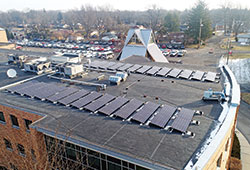Cardinal Ritter integrates new solar panels into science, theology classes

Recently installed solar panels sit on the roof of Cardinal Ritter Jr./Sr. High School in Indianapolis. In addition to reducing the school’s carbon footprint and utility costs, the panels are being integrated into its science and theology lesson plans. (Submitted photo)
By Sean Gallagher
Students at Cardinal Ritter
Jr./Sr. High School in Indianapolis ordinarily grow in knowledge through the work they do in the school’s classrooms.
But starting this semester, Cardinal Ritter’s roof is contributing to the students’ education as well.
That’s happening through the installation of 28 solar panels on 1,000 square feet of the school’s roof. They aren’t simply reducing Cardinal Ritter’s carbon footprint and electrical costs. They’re also being integrated into lesson plans in its science and theology classes to help students learn about renewable energy and how care for creation is an important aspect of the Catholic faith.
“We’re asking our students to do God’s work. And so, we’re trying to model that,” said Caroline Sperry, a Cardinal Ritter science teacher. “I tell the kids that I compost at home. I drive hybrid vehicles. I do what I can. I’m not just talking about it. I’m trying to put my faith into action.”
She’s also determined to help students learn about the science behind the panels.
“It energizes me to talk to my students about it,” said Sperry. “The emphasis on renewable energies is just going to get more important. More of our students might be going into careers in renewable energies and researching how to make them more accessible to people.”
The lesson will happen in part through a mobile device application that can show students real-time data about the energy being produced by the solar panels.
Cardinal Ritter president Jo Hoy also noted that the panels will be physically accessible for students to see, including those from grade schools in the area.
“If you want a really inexpensive field trip to see it, come on down,” she said.
Hoy also noted how the solar panels will be integrated into science lesson plans at St. Michael-St. Gabriel Archangels School and St. Anthony School, two schools in the Indianapolis West Deanery that are now overseen by Cardinal Ritter.
This excites Sperry, who looks forward to having students who will have learned about renewable energy before they arrive at Cardinal Ritter.
“They’ll already have a background in it,” she said.
Hoy said that Cardinal Ritter had long had an interest in installing solar panels and other energy-saving initiatives.
“It had been on our radar,” said Hoy. “We just financially had other needs ahead of that, because it isn’t cheap.”
Then Ryan Iannucci, a member of Immaculate Heart of Mary Parish in Indianapolis, approached the archdiocese’s Office of Stewardship and Development about his interest in helping make solar panels a financial reality for a school in the archdiocese.
“I wanted to help the younger generations understand that some of the older people do care about the world we’re handing them,” said Iannucci. “I wanted to demonstrate that and help them be aware that the pope himself has made this a priority.”
Inanucci hopes that the solar panel effort at Cardinal Ritter will motivate “the younger generation so that they choose careers and make life choices that help the Earth. Hopefully they’re having discussions with their parents about it as well.”
The leaders at Cardinal Ritter are certainly seeking to help the school take better care of the environment.
“Almost everything that we do now with heating, cooling and power, we’re monitoring digitally,” Hoy said. “It’s just part of being better stewards.”
And she looks forward to Cardinal Ritter expanding upon their current efforts.
“We shouldn’t be OK with just 1,000 square feet [of solar panels],” Hoy said. “What’s next? What else can we do? There are a lot of options. We can’t just say that we’re one and done.” †
Related story: Monastery rooted in tradition looks forward in its use of renewable energy
